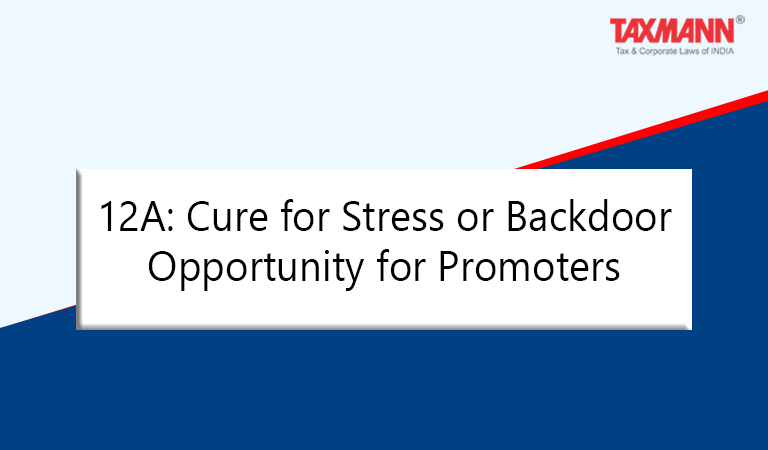12A: Cure for Stress or Backdoor Opportunity for Promoters
- Blog|News|Insolvency and Bankruptcy Code|
- 3 Min Read
- By Taxmann
- |
- Last Updated on 21 September, 2021

[2021] 130 taxmann.com 302 (Article)
Insolvency and Bankruptcy Code was enacted with a vision to provide creditors with a formidable law and a framework that will provide them to reorganize and revive a distressed entity or bankrupt person in a formidable and time-bound manner. Previously, the Indian ecosystem in the form of the SARFAESI Act, etc focused more on recovery by selling assets mortgaged with them. With the enactment of IBC, the focus shifted to reorganization by appointing an independent professional in the form of an Insolvency Professional who will try to resolve the company through a market-driven solution.
In the early phases of the code, promoters of the company were not aware of the IBC and the framework thereunder. As and when an application under the code got admitted, it was observed that the management/promoters of the company were quick on settling the matter with the applicant, may it be financial or operational creditors.
As and when the matter was settled with the applicant, the application was moved to Hon’ble NCLT. It was noted that the insolvency procedure under the Code was in proceeding in rem and there was no provision as well as power present with the Hon’ble NCLT to withdraw the applicant on account of settlement between creditors and corporate debtor. The matter reached to Hon’ble Supreme Court through the appellate procedure, where the apex court allowed a settlement between the corporate debtor and the creditors using its inherent powers under Article 1421 of the Constitution of India. In this matter, the Apex court set aside the order of the Hon’ble NCLT & NCLAT and held that the tribunal cannot exercise its inherent powers under Rule 11 of the National Company Law Appellate Tribunal Rules, 2016 & the National Company Law Tribunal Rules, 20162 to provide for the withdrawal of the applicant under IBC on account settlement.
This led to a flood of applications being filed with Hon’ble Supreme Court where the apex court has to continuously exercise its power under Article 142 of the constitution to allow the withdrawal of applications under IBC. The matter related to ‘Withdrawal of CIRP Proceedings Pursuant to Settlement’3 was taken into consideration by Insolvency Law Committee (Hereinafter referred to as ILC) in its Report, published in March 2018. The ILC Report, 2018 observed that The Insolvency Law Committee unanimously agreed that the rules may be amended to provide for withdrawal post-admission if the CoC approves of such action by a voting share of 90%.
ILC, while discussing the same matter, noted that the design of the Code is based on ensuring that “all key stakeholders will participate to collectively assess viability. The law must ensure that all creditors who have the capability and the willingness to restructure their liabilities must be part of the negotiation process. The liabilities of all creditors who are not part of the negotiation process must also be met in any negotiated solution.”
On the recommendation of the ILC Report, 2018 Section 12A was inserted w.e.f 6-6-2018 in the code which read as follows:
“The Adjudicating Authority may allow the withdrawal of an application admitted under section 7 or section 9 or section 10, on an application made by the applicant with the approval of ninety percent. voting share of the committee of creditors, in such manner, as may be specified.”
Section 12A was to be read with Regulation 30A4 of the Insolvency and Bankruptcy Board of India (Insolvency Resolution Process for Corporate Persons) Regulations, 2016 which provided that an application for withdrawal under section 12A shall be submitted to the interim resolution professional or the resolution professional before issuing of invitation for expression of interest under regulation 36A.
Click Here to Read the Article
Disclaimer: The content/information published on the website is only for general information of the user and shall not be construed as legal advice. While the Taxmann has exercised reasonable efforts to ensure the veracity of information/content published, Taxmann shall be under no liability in any manner whatsoever for incorrect information, if any.

Taxmann Publications has a dedicated in-house Research & Editorial Team. This team consists of a team of Chartered Accountants, Company Secretaries, and Lawyers. This team works under the guidance and supervision of editor-in-chief Mr Rakesh Bhargava.
The Research and Editorial Team is responsible for developing reliable and accurate content for the readers. The team follows the six-sigma approach to achieve the benchmark of zero error in its publications and research platforms. The team ensures that the following publication guidelines are thoroughly followed while developing the content:
- The statutory material is obtained only from the authorized and reliable sources
- All the latest developments in the judicial and legislative fields are covered
- Prepare the analytical write-ups on current, controversial, and important issues to help the readers to understand the concept and its implications
- Every content published by Taxmann is complete, accurate and lucid
- All evidence-based statements are supported with proper reference to Section, Circular No., Notification No. or citations
- The golden rules of grammar, style and consistency are thoroughly followed
- Font and size that’s easy to read and remain consistent across all imprint and digital publications are applied





